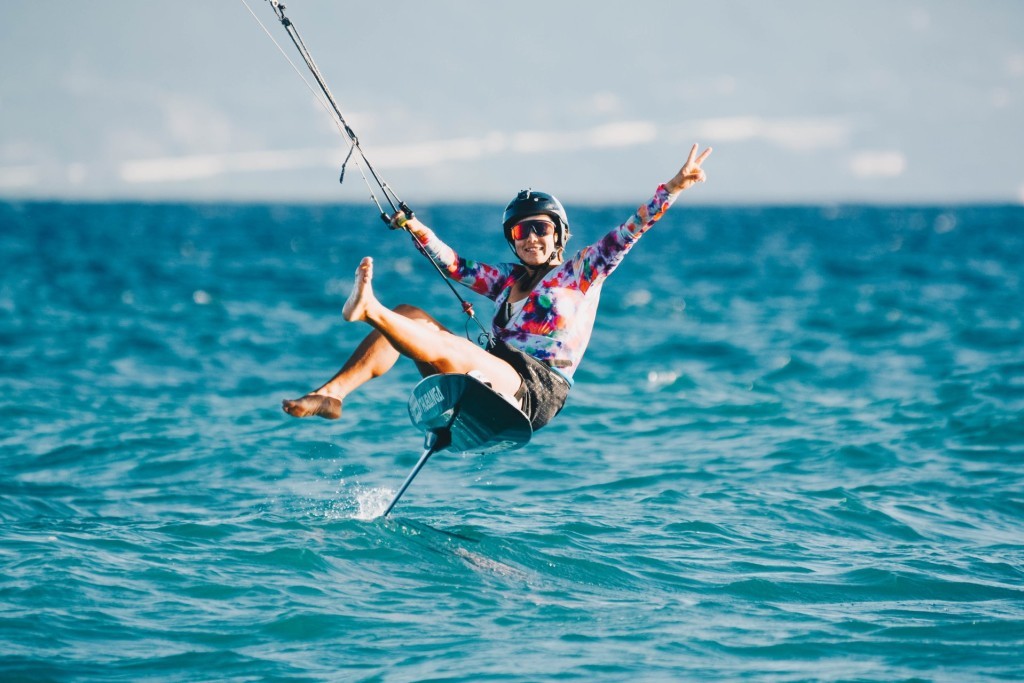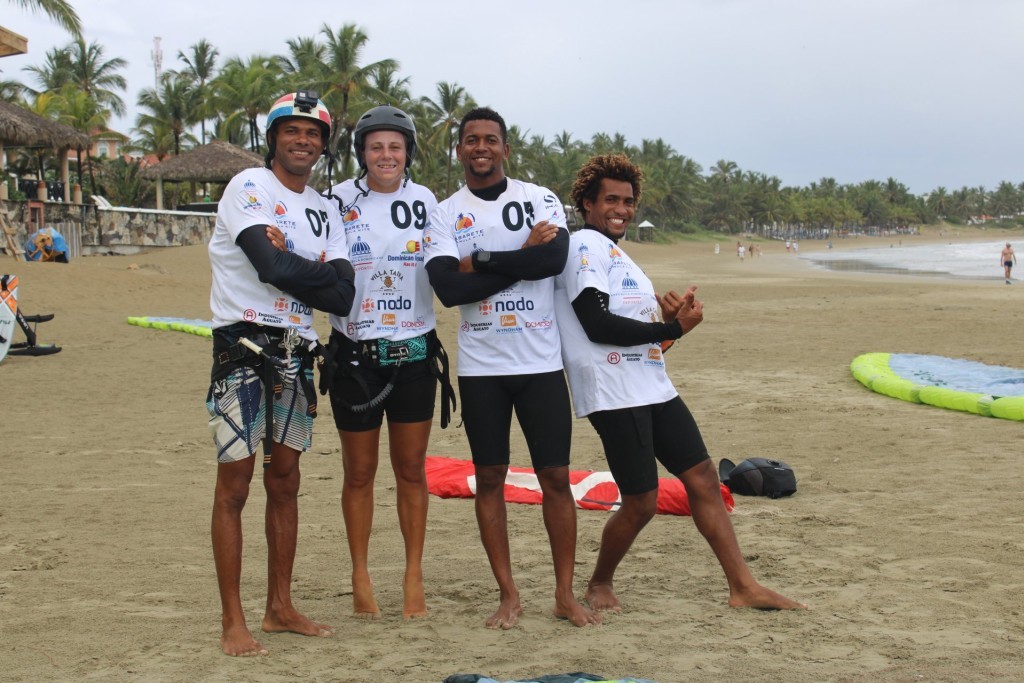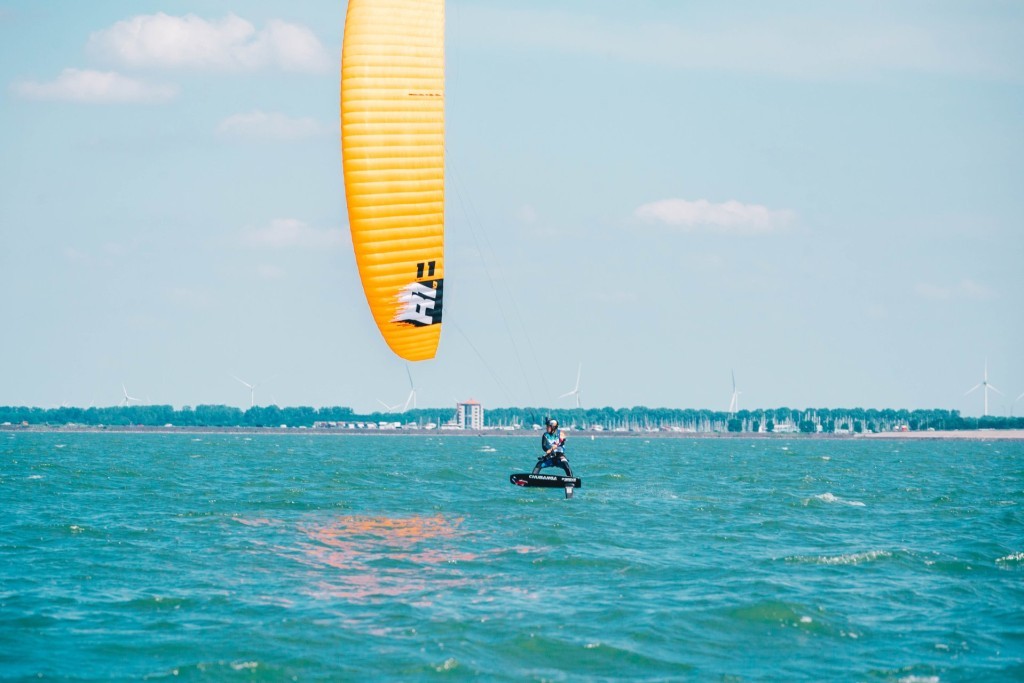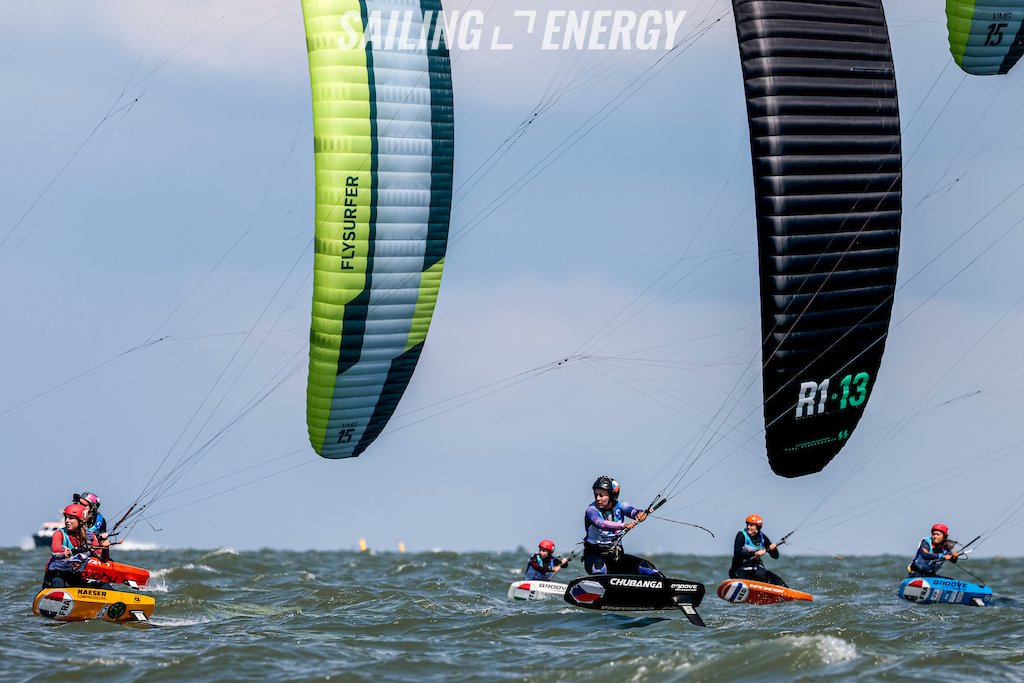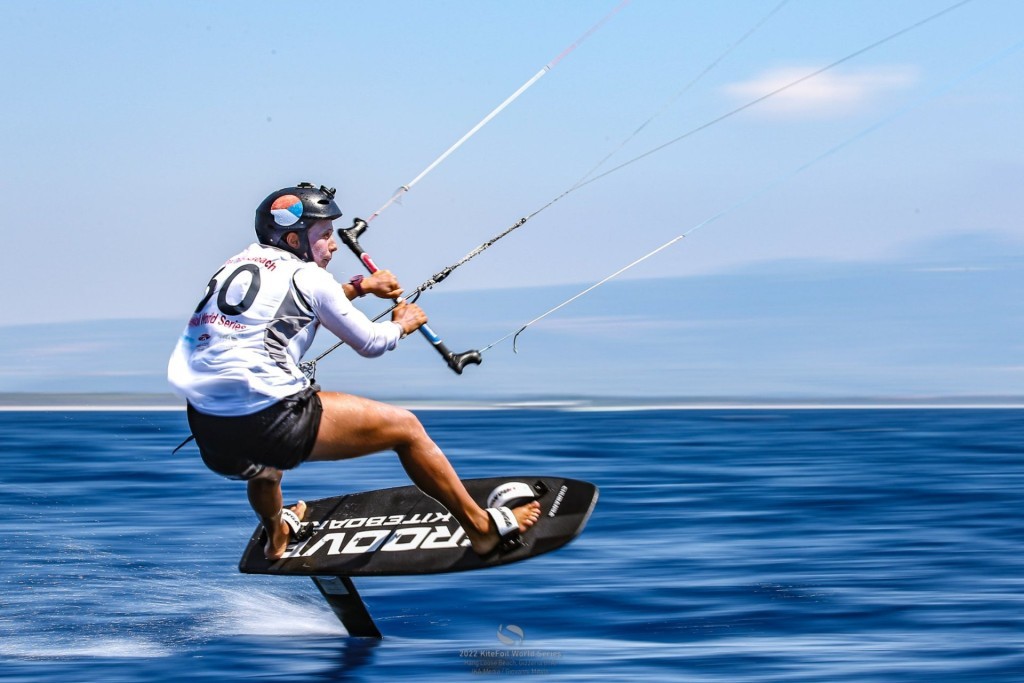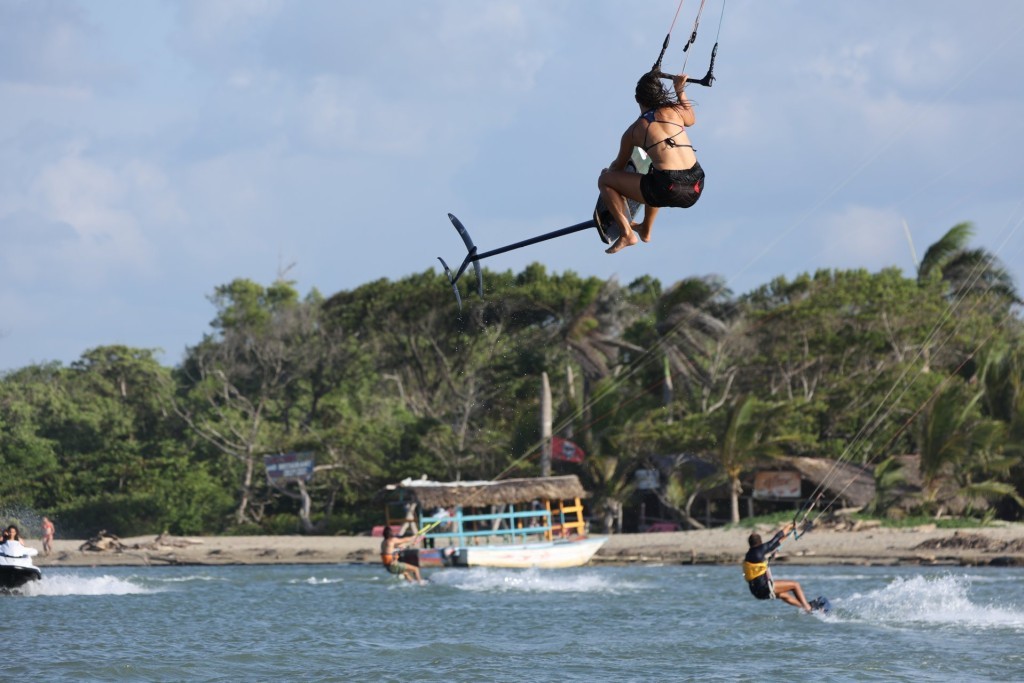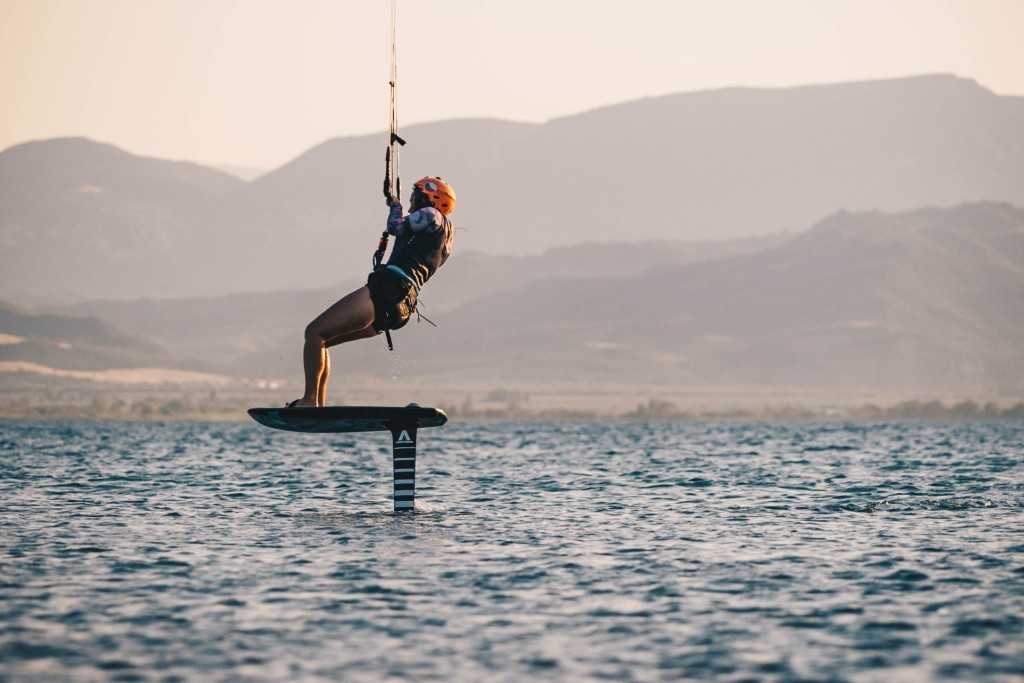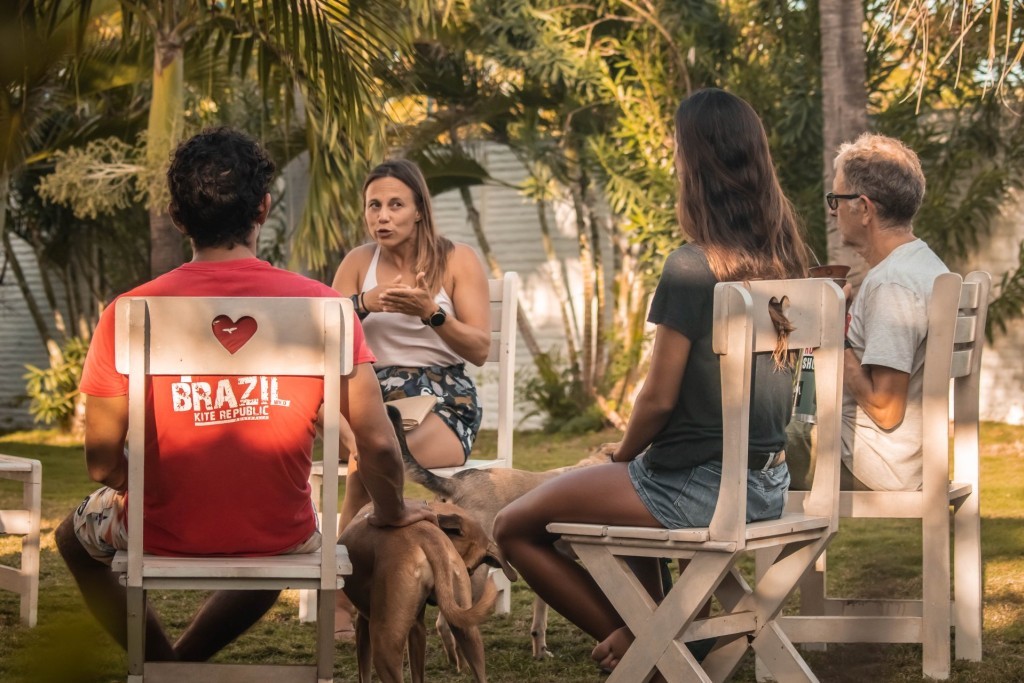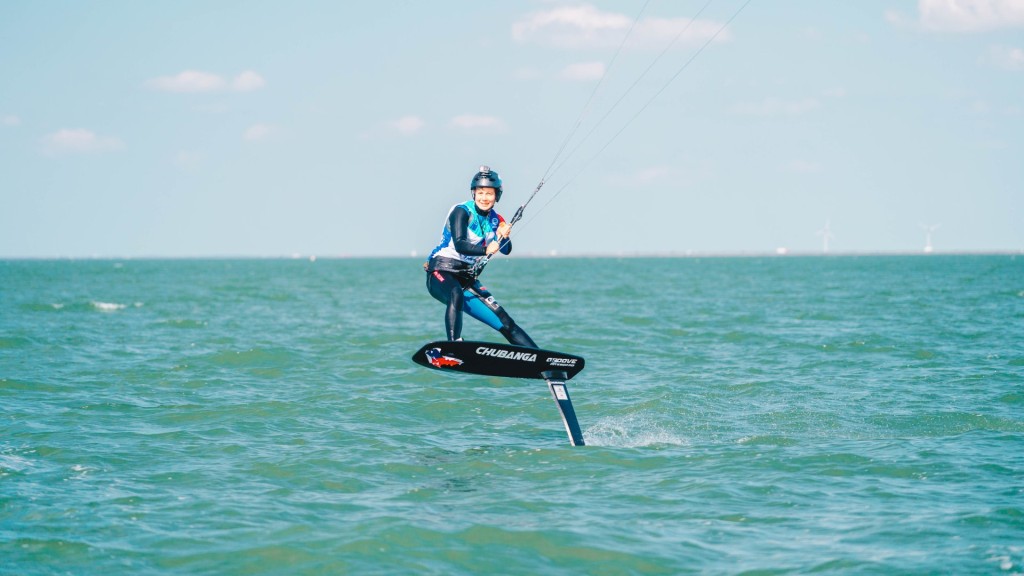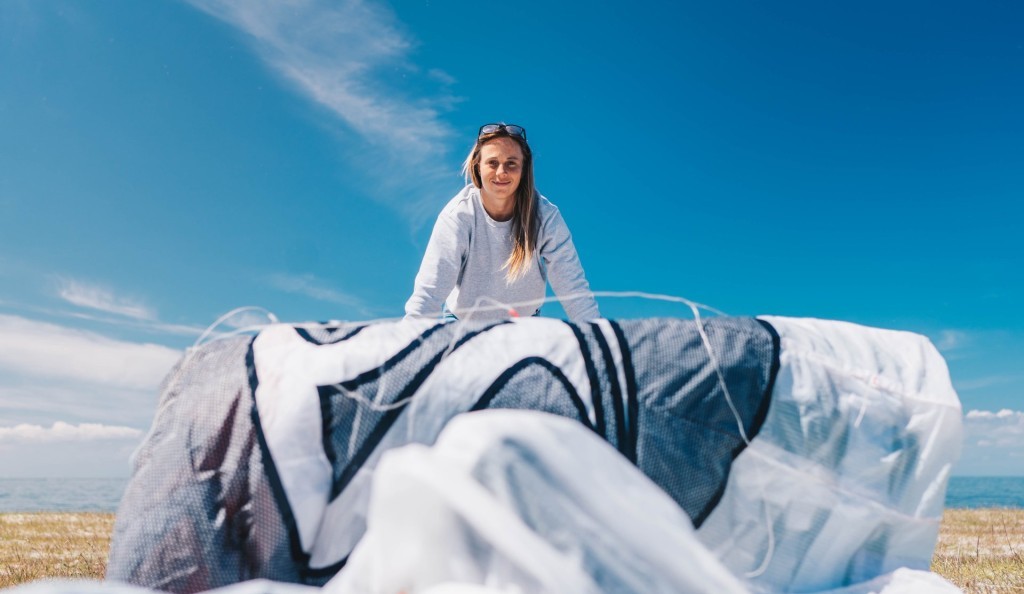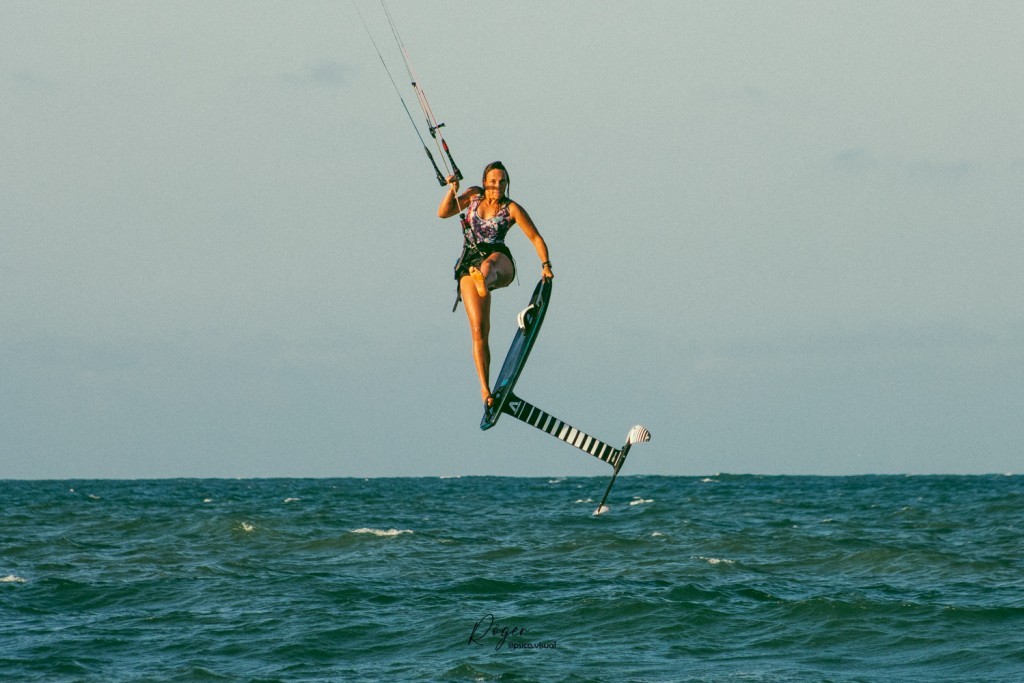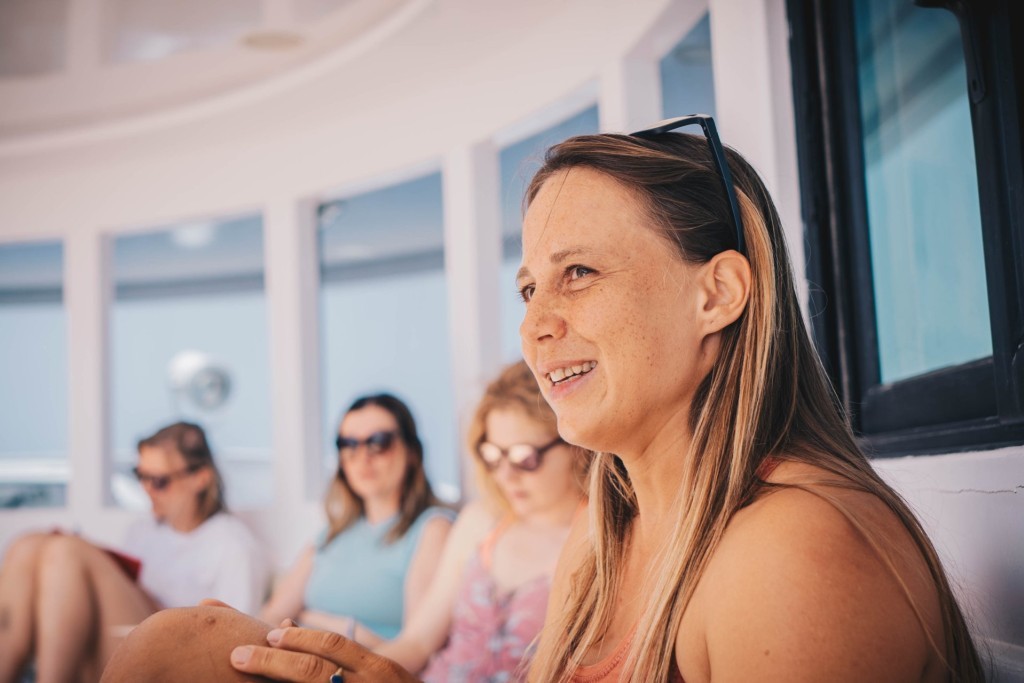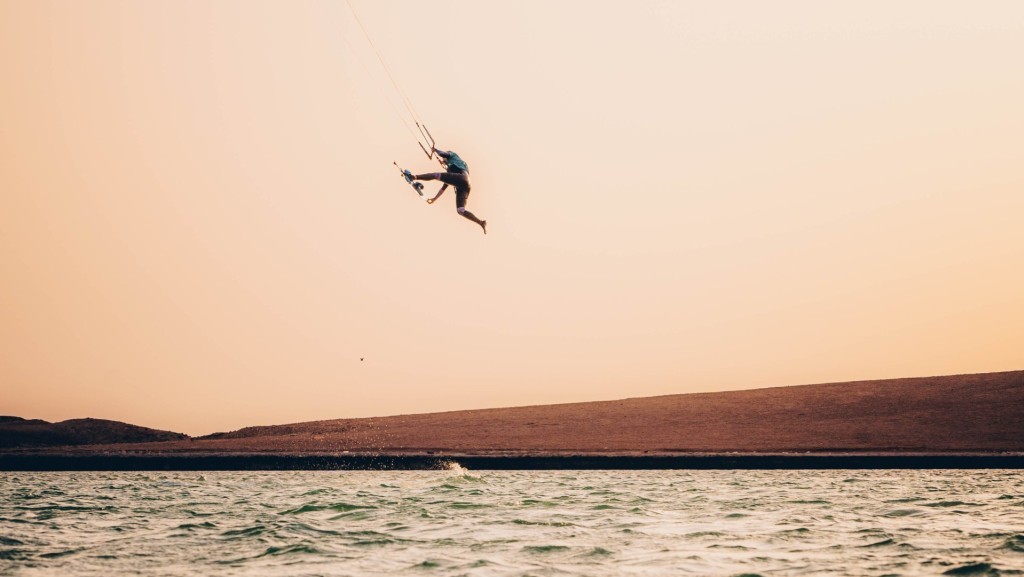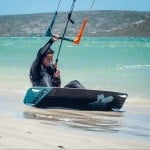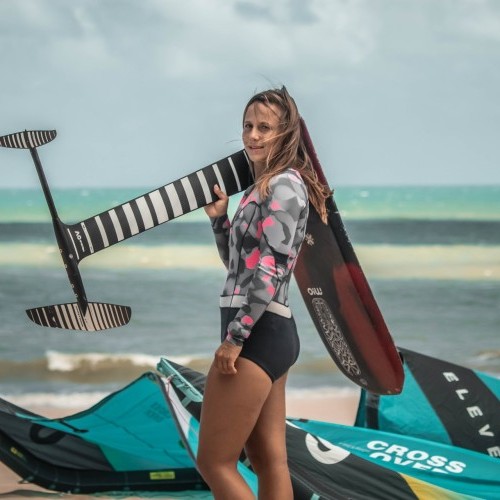
How kiteboarding can lead to better mental health – an interview with Katka Salandova
Features / Thu 15th Feb, 2024 @ 9:00 am
She moved out to the Caribbean in order to follow her dream, started to compete in kiteboarding professionally, and is now training for the Olympics in race foiling. Laci Kobulsky interviewed Katka not only about her foiling career but, more importantly, about her work – mental coaching for athletes. Over the years, she helped many professional kiters like Paula Novotna or Bruno Lobo, but her tips in this article can help a wide array of athletes, beginners, and casual riders, not excluding them.
Hello Katka! How are you doing today? Where are you and what are you up to?
Hi, I am doing very well, just enjoying the windy and sunny days here in Brazil.
So, first fun fact about you: You just took part in the GKA World Championship in freestyle hydrofoil, and you competed with the guys as the only girl! How was it?
Honestly, it was amazing! I just dared to go for big kiteloops, backroll kiteloops and kiteloop board off transitions. I have never gone so big. The conditions were the toughest I have ever had – big beach break, big waves and strong wind. And I have just been getting comfortable with strong wind in the past two weeks. On top of it, they changed the mode of the competition five minutes before my first heat. I was impressed how I managed to combine total calmness and joy with daring to go big and just send it, things I learned from my foil coach Alex Soto and mental coach Ann-Kathrin.
Ok, so let’s backtrack a bit… Where are you from, and what is your athletic history?
I was born and raised in the Czech Republic and lived there till the end of high school. My love for sport has started at a very young age. I learned to ski before I could walk, started snowboarding at the age of 12, and learnt it by myself in the backyard of my grandma’s place. And then, when I was like 14, I saw kiting in some travel magazine and wanted to do it really badly, but my parents wouldn’t support it. So I stayed with snowboarding, tennis and football ;-).
In my early 20s, I got into rock climbing during my studies in Mexico and the Austrian Alps and finally started kiting, windsurfing and surfing. But it was in the past 4 years that I moved to the Caribbean and started following the wind properly. Basically, for the past 10 years, those outdoor sports have been a big part of my everyday life, next to studies and work.
And how did you do compared to the other guys?
I have always liked to shred with guys, as I have felt I can improve more. Now, there are many more girls on the same level as guys than back in the day. The goal of this competition was to try what I could do, and I accomplished it. My friends Alex Soto and Joselito Rosario were very impressed after both of my heats – just one trick and I went to the next round. I am very technical, so I started to be faster than the guys who grew up with kiting, even in race foiling. I really love how proud my training partners from the Dominican are. When they presented the results, Joselito proudly showed me that I am among the 9 best in the world – the only woman.
When did you start kiting, and how were your early steps?
I was 22, and it was a month before I left for Mexico for a year of studying. I literally spent all my money on the week course in cold and rainy Denmark. As students, we were on a low budget and were staying in a tent – we got flooded and had to move our tent twice during the night. But I managed to go upwind in a lagoon. There, I experienced for the first time how much patience one has to have with this sport – we had in total like 5 hours on water because the wind was either too light or too strong. I learnt properly later in Mexico, also at a lagoon.
I remember you once told me that you had a fear of water, especially open water like the sea and lakes… That’s a bit odd for somebody who is competing on a world tour, haha. How did you overcome that fear?
Oh, it is sooo odd. Sometimes I think about it, especially when I go racing, when you go 50-60 km/h, so you are very fast far from the shore. It is just incredible that I am able to do it now.
From today’s point of view, I would say there are two approaches to conquer fear. The first one is difficult, painful and stressful – the so-called conditioning. You approach the fear in controlled conditions and connect it with positive and relaxed feelings. This way, you get used to a fear and learn to control it. This practice is not the most effective one as the essence of the fear remains and can be triggered anytime. I did not know any other way, so it has been pretty challenging and exhausting sometimes. It was very limiting, as I would not dare to try new tricks as I feared I would fall, lose the board and a monster would come and pull me down. So, my progression was pretty slow.
Then, towards the end of my psychology studies, I got to know EMDR – an amazing and very effective technique that liberates any fears or limitations properly, sometimes within just one session. The very beautiful thing is that this approach is very smooth and comes naturally from the inside. The fear feels very distant or disappears; there are no emotions or tensions connected to it anymore. Now, I am able to see the danger of deeper waters when I am far away from the shore, but feel comfortable and relaxed to kite there.
Do you remember how it felt the first time you dared to go into the deeper waters?
It was on a windsurf, and anytime I would fall (and this happened all the time in the beginning), I would be panicked, trying to get my body on the board. Then, I can remember one time in Holland when I had to have a pretty long swim to the shore with a student, as she had released all her equipment. Suddenly I realised that I was not freaking out! But with race foiling, it was only until this year that I dared to go on the open ocean behind the reef by myself. As with the equipment, anytime, anything can happen, and then you are just swimming out there. But it was just the best feeling, being there alone on the open ocean. Just me, foil, kite, wind and the ocean.
Your main focus right now is the Olympics and race foiling. I met you a few years ago in the Dominican Republic when you were just learning how to foil, so I was really surprised when you told me one year later that you were training for the Olympics! How are your chances looking right now, and how does your training look?
Yeah, it was always my dream. But as you say, the most challenging was to convince my pragmatic self and allow it to myself to just invest tons of hours into learning a new sport. My big question was: will I ever be able to reach the top level? This was one thing that was a bit limiting. I committed and was training a lot, but I always had this question on my mind: does this make sense? Will I be able to win?
After my first competition, after 5 months of training for the Pan-American games, I was in 20th place on the world ranking, which was an amazing achievement. I got into the rankings right after the women who have been training for a few years with a proper team and support around them. Right now, I am concentrating on better funding for my campaign in order to be able to compete on the same level as the other girls.
My training has changed a lot since I started. I used to spend 4-5 hours in the water and also gave kite lessons. This January, I have changed a lot – cutting the training time on the water by 60% and putting more focus on quality and really focused sessions combined with a lot of mental work and relaxation and recovery.
Do you have a coach, or do you train alone? You have to have other people around to train racing, correct?
Everything started with “a typical situation”, me attaching the rear wing upside down to my foil during my first week of foiling in Cabarete. Alex Soto, the current vice-champion in kite foil freestyle and winning race foiler, passed by and corrected my mistake. From there on, he has become my coach, both in racing and now also in foil freestyle.
I mentioned my Olympic aspirations to him, and from there on, he has been an incredible support. It is not just about technique but also about his incredibly calm approach – emphasising qualitative and analytically intuitive sessions, which has brought me much further than I have ever thought. He always believed that what he could do, I could do as well. And this started happening. In the beginning, there were five other Dominican guys training with me and Kirsten O’Brien. And yeah, in racing, it is important to train with others to match the speed and angles.
Also, I know it’s quite expensive to have the proper gear and to travel to the comps; how do you manage?
Honestly, the answer is that I don’t even know. A lot of it was just figuring it out at the moment, and Samantha Chilvers was also a big support, making me believe in the unbelievable. Like my first competition, I got the gear two days before it started. I have invested a lot of time and money into it. In the beginning, I also had a lot of luck; my first proper kites were undestroyable.
There was a lot of support from different parts. Parallel to my training, I started to develop a strategy on how to fund my campaign using my revolutionary program that boosts peak performance in athletes. So, one of the ways is an online program, 1:1 sessions, and a community I am building to show athletes how they can come to their next level of being more effective, happy, and healthy.
I also want to ask you why you set out this goal for yourself. Most people who start foiling just keep enjoying it, but you put all that pressure onto yourself. Was it your dream for a long time? Tell me you arrived at this decision.
It was a combination of the need to have a goal in kiting to elevate my motivation. The other reason was to amplify my experiences as a sports psychologist to understand what exactly is going on in your body and mind when you compete. But in the end, it was just love at first sight. Already two weeks after my first attempts on foil, I was given a race foil to try… And I just fell in love with the speed!
So, where are you standing now? Did you secure your spot at the Olympics already, or what are the next steps?
I am in the qualifying process. In the middle of March 2024, there is the European Championship, where I will be competing to qualify my country for the Olympics.
You moved to the Dominican Republic around COVID times and started training with great foilers; do you think that helped you along the way? Do the place and people you train with play a big role in your athletic career?
Oh, I would say that was the crucial part of my impressively fast progress. Everyday wind, constant in different wind speeds and different wave surfaces. And yeah, the people I was surrounded by, especially during the first half year, made all this possible. They made me believe in myself, that I can do it and that I am not a fool for having such a goal. Like my first competition, I received the registered equipment two days before and tried the foil just once – not very optimal. I registered on the day of the competition, but I can still remember how my goal was not to get last, as I didn’t understand the circuit well. There is also a love story connected to my foil beginnings…
Love story? Can we learn more about that?
Well, honestly, it is a story for a movie full of Latin American drama and an incredibly deep and unconditional love that has accompanied my whole foiling progress. Interestingly, this has made me grow a lot. Both foiling and interpersonal interaction are something very sensitive. In both, I have learned that any thought influences our behaviours and reactions in good or bad ways, and we can decide which way we steer the steering wheel. I am working on a movie project on this, so you can look forward to the juicy parts combined with scientific insights into relationships.
What is the biggest success that you had as an athlete for you personally, and why?
For sure achieving the level of other race foilers within a short period of time with very scarce equipment. Also, one of the goals was to be able to kite when my coach could not and be as fast. Well, I have achieved the level. I had not really thought I would ever be able to reach it, so it was amazing when I finally did.
Why foiling? What do you enjoy about it so much?
Foiling is, for me, the ultimate machine that brings you into a flow state of body and mind. A state of a high focus and concentration where everything is just happening automatically without any effort. It feels like flying – I could spend hours chasing the wind on the open ocean. It is the greatest connection with the wind and waves, and if you relax, you will just become a part of your surroundings.
Lately, it also brings me into a very deep state of meditation, bringing me very new and innovative ideas in different areas. Honestly, I love it, how I can lean into the harness and not need to use my arms.
You also have a very interesting job. You studied psychology, and you try to help athletes overcome their fears and help them with their athletic goals. Did your own experiences motivate you for this path?
I have a very innovative mind, and if I feel like things don’t work or are not really helpful or effective, I try to find better solutions. My own experiences make me find new ways of making athletic progress more joyful and effective. And, of course, from my own experience, I know how powerful progress can be – especially releasing fears or limitations and using your mind to its full power, using emotions well.
I see a lot of potential in the work I do with athletes. So, in order to fund my Olympic campaign, I have developed a framework and an online program through my business, Kelios Coaching, for athletes as a first step to a more effective way to peak performance.
So, what does a session with you look like? How many sessions would one need to achieve some results? And it is mostly talking?
Sessions with me are unique and different from conventional techniques in the amount of talking. My goal is that the client feels an immediate change. Everyone knows that saying things is much easier than feeling and really doing them. And so, through talking techniques, you can teach clients to control their feelings or emotions, but it is a very superficial approach that needs a lot of effort. During the session, I access the goals and the blockades and implement techniques that have the power to change the automatic programs our nervous system is running on. Getting rid of a blockade or a fear can be done within three sessions on average. The 12-week program is an introduction to all the basic techniques and has been very successful in seeing impactful results personally and on athletic performance.
You recently told me about the concepts of mindfulness and flow. Can you please explain these two terms and what they mean to us?
They are interconnected; we could say that through different mindfulness techniques, you can achieve a state of flow. A state in which you challenge yourself but have abilities to master it, where everything feels easy and automatic, and you are highly focused. It is comparable to deep meditative states as your brain runs on alpha and theta waves. Being mindful means being in the present moment in the here and now, totally aware of what is going on in your body and mind. Some people talk about states of ecstasy.
You told me that you are using foiling as a tool to achieve the state of flow. How can one benefit from that in the other aspects of life besides foiling and sports?
When you get into a state of flow, you are highly focused, and any tasks are just happening automatically; you are very efficient, and your memory is highly receptive. So if you want to be highly effective at work or while studying, this state of mind is very beneficial. On top of it, different aspects can be implemented into a flow state of mind.
So, do I understand it correctly: I can learn how to get in the state of flow during foiling, and later, I can get back to it, let’s say, while I have to work on the computer transcribing this article? (Instead of going on YouTube and watching yet another cat video, haha)
Exactly, through foiling, you can experience a very impactful state of flow. Using special techniques, we can train your brain to construct a strong neuropath with the result that you will enter this state of mind whenever you want. It can be done also without foiling, but foiling makes it much easier.
But how does this work in practice? I can imagine a state of “flow” when I am kiting, and I am solely focused on what is happening at the present moment. But how can I get into this state when I am off the water?
There are many times you want to be in the state of flow and high performance, like a competition, an important meeting or just everyday work or training. Using EMDR and visualisation techniques, we activate the same centres in your brain that are active when you are actually experiencing flow. So you enter flow during my session (some people even say they feel like they were on mushrooms), and then we connect with a colour or another symbol. For the next week or two, practise this visualisation for 10 minutes a day in a silent place. Then you can just think of the colour and you will immediately feel in flow. We go further and can implement different states of flow – for work, for competition, for training or for studying…
I want to come back to overcoming fears. Can you give us some tips on how we can overcome some fears that we have?
The easiest and the most effective way is to get an EMDR session and release this fear properly.
Breathing and smiling are also very powerful techniques. If you just try to concentrate on your breathing, you get into the present moment, away from your thoughts or emotions. And smiling activates all the muscles connected to positive feelings.
There is also a very impactful guided visualisation I use, with the goal of transforming the fear into something funny and empowering. You can listen to it on my online program or YouTube channel.
And how do you work with athletes? What are the methods you use to help them with their goals? And what those goals usually are?
My approach has two parts. In the first one, we have a look at any limitations, blockades or fears and release them with a very effective method – EMDR. Then, we set the exact goals and program the brain towards them using different techniques like entering flow, relaxing profoundly, and being mindful of the body and mind.
The most common method is to overcome nervousness in competition and be able to focus at any time on 100%. Other topics are mostly how to make training more efficient and how to perform at the best and still enjoy it. Limiting beliefs like ‘I am not enough’ or ‘I am not confident’ or ‘I am fearful’ are also a big part. Finally, sleeping issues, especially during competitions, are a common problem.
If it’s not confidential, which athletes have you worked with so far and would you have some concrete examples of how you managed to help in some situations?
Paula Novotna has been my client for several years, and our big achievement was being calm and focused during competitions as well as consistent during her heats.
I would say one of my biggest achievements was working with Brazilian athlete Bruno Lobo. He has just won the Pan-American games and qualified for the Olympics in Formula Kite. He has been working a lot on his physical fitness, but up until a year ago, he was not training his mind at all and not sleeping well. Also, he had issues with consistency – when he would win or perform very well, then the race just after would go bad. After our work together, he had amazing results in the Pan-American games – he managed to win all the races.
How can we help our sports mentally? And in the other way, how does sports help your mental health in the other aspects of life?
Many scientific studies confirm that the mind plays a substantial role in our sportive performance. If we train the mind correctly, we are able to accomplish our goals much more effectively and faster and minimise injuries or accidents. There are plenty of techniques that can be used to calm down, be more stress resistant, focused, confident and energised.
With the right techniques, you will be able to act at your best anytime you want. Some of the easy ones are using your breath to strengthen your body and mind awareness, implementing rituals to be more focused, learning to get out of the water before you start making too many mistakes and avoiding frustration.
After each session, find all the positive things. Be aware of your thoughts and emotions – those shape your performance on water. For example, if you want to do an elegant rotation, think of a ballet dancer, and right before you take off, say to yourself: “Elegant”.
There is a very impactful first auxiliary exercise I use with my clients to liberate them from their fears. You can listen to it in my online program or YouTube channel.
Sport is a very effective way to change your life in many ways – it boosts your confidence; during the sport, experiencing high-performing flow can be used in everyday life if you wish to be highly productive. Kiting, especially foiling, can be used to relax properly and get into a highly focused and meditative state of mind, which can lead to exceptional creativity. Through sports, you can learn to calm down your nervous system in highly stressful situations, which your body automatically uses in any stressful situations. My clients from female kite-mind retreats (SHE-FLIES) mention how the techniques they used for kiting help them to be calm and focused before important business meetings.
Where do you want to take your career in the future? Any plans, visions or dreams?
I want to change the peak performance paradigm we have in the athletic and business world. It is believed that if we want to reach the highest goals and overcome the biggest challenges, it has to be stressful and painful. Based on scientific research and the neurobiological functionality of our brain, the work with my clients and my own experience, I am convinced that the correct implementation of mental preparation, better recovery, relaxation, and minimising stress is a much more effective, healthy and satisfying way to reach far behind set goals even faster.
I plan to have a kind of wellness training / self-development centre at a beautiful place at the beach and in the mountains, where athletes or high performers from any professional area can come and learn to relax and perform their best more effectively.
One of my passions is to empower women and enhance their confidence, both in sports and in professional life. The methods I use have a life-changing impact, so I wish to spread this knowledge to a very broad audience through self-development kite retreats and festivals with SHE-FLIES.
And what’s next for you as an athlete after the Olympics?
To keep on spreading my revolutionary mental coaching program among athletes all over the world, adapting it to different disciplines, and accompanying a few Olympic athletes to a gold medal. I want to continue competing in the race foil competitions and go for the Olympics in 2028, too. I would like to spend another winter in the mountains rock climbing and snowboarding; for example, powder riding in Japan is at the top of my list. Of course, there is a desire to learn some new languages, and now and then, I am thinking about a neuroscientific PhD on the topic of flow in foiling.
Thank you, Katka, for your time, and we wish you all the best in your work and on the path to the Olympics!
Interview by Laci Kobulsky
Cover Photo and Thumbnail Photo by Janika Kamm
By Crystal Veness
Editor at IKSURFMAG, Crystal Veness hails from Canada but is based in South Africa. When she isn't busy kitesurfing or reporting on the latest industry news for the mag, she is kicking back somewhere at a windy kite beach or working on creative media projects.


